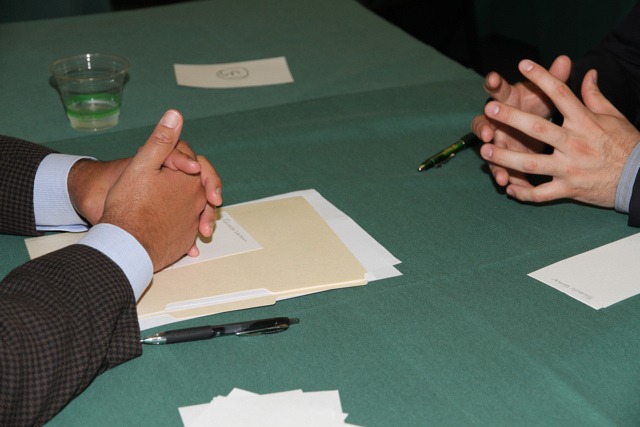5 Steps to Successful Nonprofit Staff Hiring


Full Platform Overview Chat With Us



Full Platform Overview Chat With Us




No matter the size, every nonprofit must build a strong team in order to be successful. I have had the privilege of being on the selection committee for hiring four new executive directors for various nonprofits over the last several years. In all but one of the cases we used the process you’ll find below. It was taught to me by a wonderful management and human resources consultant back in the 80’s, and I’ve been using it ever since. The best part of this process is that it has stood the test of time and has been enhanced by technology. Here is my five step process to a successful nonprofit team hire:
 1. Cast a Wide Net
1. Cast a Wide Net
The first step is to cast as wide of a net as possible searching for potential candidates. The larger the pool of candidates the greater the chance you have of finding a truly special person. Think in terms of PR and social media: networking and communications are key elements. The hidden secret is to never stop the process! Keep networking and your list of potential team members will grow.
2. Email Open-Ended Questions
The ability to write is a vital skill in just about every single role associated with a nonprofit. It is also an easy manner to whittle down whatever size pool of candidates you have assembled. My preference here is to email out a list of ten open-ended questions to every candidate after your initial communications following an inquiry into the position.
Make sure you write questions that:
It is best to let them to ask you 1-2 questions back. By limiting the number they can ask, you make your review easier and it forces the candidates to be insightful. Be sure and note how many of the candidates meet or beat the deadline as that is a superb indicator of their future ability to do so.
This step should allow you to reduce the pool of candidates down to 4-8 who move on to the next step. If possible, use 2 or more existing team members to help select those who move on to the next step.
3. Short Telephone Interview
Next, schedule a 20-30 minute phone interview with your leading candidates. You goal is to not only find out more about them, but also to see how they handle themselves over the phone. Have the same 10-15 questions prepared for all candidates, and be prepared to write or type their answers so you can review them later. In addition, you should write your impressions of the candidate right after the call while they’re fresh in your mind.
The nature and type of questions are key to insights gained and comparisons garnered. Here are some suggestions to help:
We always make sure 2-3 people conduct the telephone interviews thus providing your tem with multiple opinions and rating sheets to compare. Once all the interviews are completed and the rating sheets reviewed, pick the three finalists to move to ensuing step.
4. Face-to-Face Interview
By now, you have established their writing skills, telephone communication skills, the type of thinking they exhibit through their answers to your open-ended questions and the types of questions they ask you.
Now, it’s time for a face-to-face interview.
This step should provide the finalists a chance to meet multiple members of your team and to experience your organization’s environment.
Here are some key parameters to keep in mind for the face-to-face interviews:
All of the interviewers should gather as soon as possible after the interview sessions end to compare evaluations. The top two should remain for the last step, but keep the third person ready should one or both of the finalists not work out.
5. Leadership Presentation or Immersion
Here, choose between either a presentation to leadership or immersion.
The leadership presentation is designed for your team to see first-hand the finalist’s talents in the following areas:
Challenge the candidate to pull together the details of a game plan for their new role and present the details without handouts or slides. They must work from a white board using only their words and gestures.
Whereas a leadership presentation is ideal for those applying for a leadership role, immersion is ideal for a non-leadership role. These finalists spend either a half day (or preferably a full day) shadowing current team members and performing or interacting with other team members in the same role.
The goal of this exercise is to provide a real life, long-term view of what the job and the environment entails and requires. It also helps eliminate surprises later. Both the finalists and the other team members have a chance to see if it feels right.
For both options, the team members involved should huddle to review all the information from the original email questions to the final step. This is bringing many of the new team member’s future peers into the process, which pays many long term dividends! In most cases, a clear winner will emerge due the completeness of the process. This process helps ensure only the best fitting and most top-notch candidate is added to the team.
It’s Not Just For Your Internal Staff
Keep in mind, various portions and variations of this process can be used for selecting board members, recruiting volunteers, finding partners and choosing consultants or vendors. There’s no reason why those individuals shouldn’t be as involved and committed as yourself or your top employees. Just imagine a board meeting where every board member:
Sounds like a slice of heaven, doesn’t it?
Finding the best team members of any type can make such a difference for any organization moving forward! Pick and choose what best fits your organization and its needs for the future. Now you have five concrete steps which allow you to do just that. Best of luck in building your team!

Comments
Martin